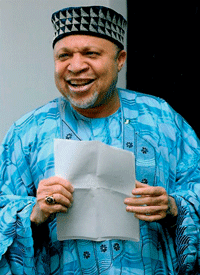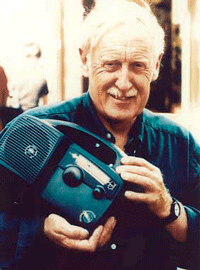
IP Outreach: World Intellectual Property Day & Trevor Baylis, Inventor: the Clockwork Radio
World Intellectual Property Day: "Intellectual property – It starts with an idea…"
The extensive worldwide press coverage of this year’s World Intellectual Property Day on April 26 confirmed growing recognition of this annual event in marking the importance of intellectual property (IP). Mr. Praveen Dalal, an arbitrator practicing at Delhi High Court, commented on IP Day events in India: "It seems the need for celebration of World IP Day is very pertinent. Public awareness is missing and I hope that celebrations like these will fill that gap." Over 70 Member States and organizations have reported back to WIPO on their World IP Day activities, demonstrating their enthusiasm to make the most of this opportunity to increase public understanding of IP around the world.
Events to mark the day varied from large scale gala evenings with live concerts and award * ceremonies, to local folkloric music and dance festivities, to exhibitions in IP offices. Some countries were celebrating the event at the national level for the first time. Others built on their technology and innovation promotion days dating back long before World IP Day.
The highest concentration of events celebrating World IP Day was reported from countries of Eastern Europe and the Former Soviet republics. Kyrgyzstan got off to an early start in March, making effective use of the media and the Internet to promote their very full program of seminars, workshops, exhibitions, awards and tournaments.
Australia aligned their National Innovation Festival with World IP Day for a joint celebration of innovation and creativity. Selected IP ambassadors promoted the event, which featured on television shows, websites and in newspaper articles. The staff of IP Australia joined the fun with a "great debate" and quizzes.
Young people

Jisoo Kim, from Joongwon Middle School, won first prize in the Korean IP Day essay competition. (Credit: Korean Ministry of Culture & Tourism)
The Korean Intellectual Property Office focused activities on school children, with an essay competition for young students based on the Korean comic, Copy and paste: What’s wrong? Almost 9,000 students participated in the competition. The Uranga Entity Institute of Kenya, an independent public policy research project, also held an essay competition for high school students based on the IP Day theme.
In Hong Kong, the Intellectual Property Department joined forces with the Hong Kong Scout Association to organize the "Respect for Intellectual Property Rights Fun Fair," with scout groups participating in seminars and workshops. In Malta children aged eight to twelve took part in a drawing competition on the theme "Ideas shape our world." The Office of the Registrar General in Lesotho reported that this year’s theme held "particular appeal to the youths of the country to be creative."
Protecting creators’ rights
Many IP offices targeted specific rights holders. The Burkina Faso Copyright Office invited some 180 rights holders to discuss the nature of their rights and how to exercise them. Belize held a seminar on trademarks and the international classifications of goods and services. Activities in Denmark centered on copyright, its value and economic contribution to society. The focus in Hungary was on creativity in the field of design; in Barbados on trademarks and local brands; and in Bulgaria on invention and utility models.

Nigerian Ambassador Joseph Ayalogu at the Washington screening of Wetin Dey.
The themes of enforcement of IP, and anti-counterfeiting and piracy, were at the forefront in many countries. China held regular press briefings giving status reports on progress in enforcement. Kyrgyzstan organized a "Stop Piracy!" event, which involved the destruction of counterfeit audio-visual works. In Samoa, rights holders’ involvement in a copyright awareness-building program explained to the public the role of creators and their need for compensation for their creative work. Presentations, discussions and campaigns in Belgium, the Dominican Republic, Germany, Mexico, Peru, the United States, Zambia and others highlighted the problem of piracy and respect of IP.
Costa Rica held an exhibition of works by two national artists, a writer, a cartoonist and three children, in conjunction with a national anti-piracy campaign on television and a cycle of conferences on copyright and related rights in public schools. In Peru presentations were staged where people gather to enjoy creative works: cinemas, theatres and concert venues, both in the capital and provinces.
The reports from Member States, which are still coming in as this article goes to press, confirm that World IP Day has firmly taken root by this, its sixth year. Ambassador Joseph Ayalogu, Nigeria’s Permanent Representative to the UN in Geneva, summed up as follows at a World IP Day screening of "Wetin Dey" to the United States Congress in Washington: "We are here tonight to celebrate a cultural event. But we are also recognizing the importance of an emerging facet of international law, diplomacy and political economy, which is the protection and promotion of intellectual property rights. Today, intellectual property has become a permanent fixture of international relations."
___________________________
* List of recipients of WIPO awards.
Trevor Baylis, Inventor: The Clockwork Radio

Courtesy: Trevor Baylis
It started with an idea…
In 1993 Trevor Baylis, a British former stuntman and under-water escape artist, came up with an idea for a wind-up clockwork radio to meet the needs of isolated communities in developing countries. Today his Clockwork Radio is used in rural villages across Africa, Asia and South America, bringing communication to communities with no access to electricity or batteries.
A prolific ideas man, who is strongly committed to helping promote invention, and with a talent for combining outreach with entertainment, Trevor Baylis has become something of a champion for small inventors in the United Kingdom. Following his guest appearance at the 2006 European Inventor of the Year Awards in May, he spoke to WIPO Magazine about his activities.
How did you come up with the idea for a clockwork radio?
It was pure chance. I was watching television one evening about the spread of HIV/AIDS in Africa. There were pictures of young people covered in flies and bodies being thrown in open graves. They explained that the only way to stop this disease was through radio communication and information. The problem was that most of Africa did not have electricity to run the radio and batteries were horrendously expensive for the locals.
When the program finished, I pictured myself for a minute in colonial Africa, sitting, smoking a pipe and listening to the scraping sound coming from a gramophone. I thought if that much racket can come from a simple nail on a disk, I could create something similar. Chance favours the prepared mind. I did a first experiment right after the show that took about half an hour and got a spark of life. Then I did an experiment with a tree and water, which got the radio running but only for as long as the tree was tall. Then I changed from water to soil, which was better, then a spring, with the final result being a spring to wind up the radio.
At the same time as I was working on the radio, I came up with a wind-up torch, a telephone charger, a solar panel... The end result was a machine that did everything and ran all day – solar powered in the daylight and wind-up at night.
What problems did you face?
There was a lot of resentment when I first came out with the idea. People said anyone could have had the idea, and that it was too easy. For four years I got no support. The BBC World Service Radio, then the Tomorrow’s World team (a science-based U.K. television program), gave me my first shot. It took off after that. Then the BBC did a show with Nelson Mandela, who got involved because ultimately the radio was designed and created in South Africa and was to be made by disabled people.
The product went to market in 1993-1994. Sadly, when it took off the company fired the 400 disabled people it employed in South Africa and went to China. Thousands of the radios are made now in China and sold around the world. You can find them in small villages and at the top of scaffolding used by construction workers. It has become a universal tool – one of those things that will be there forever.

In Afria alone HIV/AIDS has left over 4 million orphans. Radio, an essential means to educate and inform peopleon the virus, does not reach many rural communities because of the lack of electricity and batteries. (Credit: International Labor Organization/ Crozet M.)
The biggest problem is that they are still expensive bits of kit and people in rural African villages cannot afford them unless they are donated. I’ve seen 350 people sitting around my radio in Malawi. It was rock’n roll they were listening to, but it was there.
Tell us about another of your inventions.
I made an electric shoe. That was a favourite of mine. As I walked, I could generate enough power to regenerate my mobile phone battery in a pouch by my shoe. So my phone was always powered. The trouble is that after 9/11 anyone with wiring in their shoe looks like a terrorist, so I had to give it up.
I also created some 300 products for disabled people. They were called Orange Aids.
If you had to single out an invention that you particularly admire, what would it be?
The jet engine, invented by Frank Whittle in 1930. He was ignored by everyone at the time, but with determination he formed his own company and filed patents. (He received a first patent, much delayed by the U.K. Air Ministry, in October 1932). The Germans picked up on it and had the first jet planes in 1941. Britain could have had them much earlier, if we had listened to the 21-year-old Frank Whittle.
Are there areas today that you feel are crying out for innovative ideas?
Climate change is one of the biggest problems. We have to find a way to stop the amount of pollution. In the health area, we are a stone’s throw away from finding a cure for cancer. We just need the right creative minds working on the problems. But let’s also not forget the fun factor in every day living. There’s always loads of room for fun inventions like the television.
What does intellectual property (IP) mean for you?
Well, nobody pays you for a good idea. IP rights are the only thing that give you value on your knowledge. Without IP, the economy would suffer. Without it, don’t invent. Why bother?
What advice would you give someone who has an idea for an invention?
Don’t go down to the pub and tell everybody about it! Do something about it, otherwise you will regret it for the rest of your life!
What do you see as the greatest difficulty faced by small inventors?
The cost! Lawyers are the biggest problem that inventors have, because they charge them so much to file a patent, to translate the application and so on. We’ve also got to reduce the cost of litigation.
Is there more that IP offices could do to support small inventors?
We’ve got to make sure that any outfit that purports to help inventors behaves under strict laws – bring a decency factor into the equation. There are so many predators out there. Anyone wanting to know about your invention must be made to sign a non-disclosure agreement. If they don’t, then don’t show them your product. If you are going to show your product to a large company, take a lawyer.
National governments need to stick behind inventors. If a patent is stolen in a far away country, how can a small inventor know about it? Or do anything about it? They can’t afford to fight the big companies. National economies depend on innovation and inventions, so governments should be prepared to get involved and back up their inventors.
You are a firm believer in educating the young about invention and IP. How can governments help stimulate young people to think in terms of innovation?
The only way you are going to do that is by making sure that invention is taught as part of the national curriculum. We need to turn education on its head. Children have got to be taught to enjoy science. In universities, why not have a Bachelor of Invention degree, like they have Bachelor of Arts? To get a Master of Invention degree you would have to obtain a full granted patent…
You’ve got to celebrate inventions! Yes, reward inventors monetarily, protect their rights, but also give them their 15 minutes in the spotlight. Make people aware of how inventions have changed lives. Do more television programs on inventors, show how they come up with their ideas. Inspire people!
I always tell young people that all you need is slightly more perception than the average wrapped loaf and you can invent something. Don’t be worried about what other people think. I tell them, I don’t mind anyone looking down on me as long as they don’t expect me to be looking up.
| Standards for Invention Promotion Companies |
|---|
|
Trevor Baylis works closely with the U.K. Patent Office to expose unethical practices in invention promotion companies. They recently had one such company shut down as a result of a live television documentary. With the support of the Patent Office and the British Standards Institution he has started a movement to establish agreed standards or principles for all organizations which purport to help inventors. He has started his own company, Trevor Baylis Brands, to help inventors get their ideas to market at minimum cost. To date 1,800 inventors have signed up via the website, and the company evaluates approximately 100 new ideas per month. He wants to set up facilities, the Baylis Breakout Rooms, based in universities and research institutions, which would enable inventors to discuss their ideas with experts, lawyers, advisors and potential business partners, safe in the knowledge that their IP will be protected. The inventors present their ideas on camera, and everyone present must sign a confidentiality agreement. This is key as no inventor should ever disclose any information on his invention to anyone who has not first signed a confidentiality agreement. The video-taped proof of the inventor's intellectual property can then be stored safely in a bank or post office. For more information see www.trevorbaylisbrands.com |
The WIPO Magazine is intended to help broaden public understanding of intellectual property and of WIPO’s work, and is not an official document of WIPO. The designations employed and the presentation of material throughout this publication do not imply the expression of any opinion whatsoever on the part of WIPO concerning the legal status of any country, territory or area or of its authorities, or concerning the delimitation of its frontiers or boundaries. This publication is not intended to reflect the views of the Member States or the WIPO Secretariat. The mention of specific companies or products of manufacturers does not imply that they are endorsed or recommended by WIPO in preference to others of a similar nature that are not mentioned.